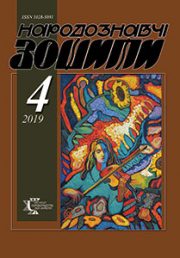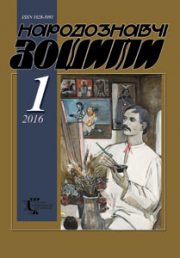The Ethnology Notebooks. 2024. № 4 (178), 894—900
UDK 7.04:726:27-523.4(477)
DOI https://doi.org/10.15407/nz2024.04.894
DECOR IN THE UKRAINIAN ART SYSTEM WOODEN CHURCH: HISTORIOGRAPHICAL ASPECT
PASHCHAK Yaroslav
- ORCID: https://orcid.org/0009-0007-6423-5449
- Postgraduate of the Department of Architecture and Conservation,
- Lviv Polytechnic National University,
- st. S. Bandery, 12, 79013, Lviv, Ukraine,
- Contacts: e-mail: yaroslav.v.pashchak@lpnu.ua
Abstract. The relevance of architectural decor in the decoration of a Ukrainian wooden church is due to the need to preserve it as an element of national identity, stylistics, and to recreate new ones in terms of semantic load and visual perception of rural and urban space on its basis.
The object of the study is the decor of a Ukrainian wooden church in the Ukrainian Carpathians.
The subject of the study is the analysis of historiography on the use of decorative plastic in the architectural and structural solutions of wooden churches.
The purpose of the study is to highlight the state of the art of studying decorative and artistic means in the traditional construction of wooden churches in the Ukrainian Carpathians and the issues of conservation and restoration of the decoration of the architectural and structural components of the interior and exterior of churches.
The research methodology is based on the application of the principles of scientificity, objectivity, and historicism, and the use of chronological and typological methods of dividing historiography.
In this article, historiography is analyzed by time and thematic division. It is divided into six groups. The first group includes studies of the second half of the nineteenth and early twentieth centuries. They are devoted to the discoverers of Ukrainian sacred wooden architecture. The second group includes studies by scientists in the interwar period. They are dedicated to the wooden churches of Galician Ukraine. Subcarpathian Rus, Boikivshchyna, and Bukovyna. The third group includes monographs and articles from the Soviet period that focus on local schools, painting, and the decorative design of iconostases. The fourth group includes research papers that appeared during the years of independence, which make a new contribution to the study of the genesis of wooden churches, their decorative and artistic decoration, and analyze the contribution to the study of wooden churches by Polish researchers. The fifth group includes works directly related to the arrangement of churches. The sixth group includes publications that examine the history of Ukrainian ornament, its symbolism, and ornamental motifs in art and architecture.
Based on the analyzed literature, it can be concluded that the bulk of publications are devoted to the restoration of iconostases, conservation of monuments of church art, and the architectural and constructive solutions of wooden churches, on the basis of which a multidimensional artistic and semantic environment with religious and folk symbolism is created through repetition and inversion. It has been found that there are no studies devoted to the coverage of intersystemic connections in the context of combining decor with a constructive solution, which does not allow to compare separated architectural components, to identify various persified meanings – undisclosed meanings of architectural symbols and signs inherent in the decor of ethnographic groups of the Ukrainian Carpathians.
Keywords: sacred architecture, churches of the Ukrainian Carpathians, architectural decor, decorative and artistic means, restoration, conservation.
Received 4.07.2024
REFERENCE
- Wolfskron, A.L.R. (1858). About some wooden churches in Manchen, Silesia and Galicia. Vienna: From the Imperial Royal Court — and State Printing Office [in German].
- Dahl, L. (1875). Ancient wooden churches in Russia. Architect, 6 [in Russian].
- Uvarov, A. (1876). Ob the architecture of the first wooden churches in Rus’. Proceedings of the 2nd Archaeological Congress, (Vol. 1, pp. 54—55). Saint Petersburg [in Russian].
- Myskowski, W. (1880). Wooden churches in the Carpathians. Communications from the KK Central Commission for the Research and Preservation of Art and Historical Monuments (Vol. 6, pp. 26—29). Vienna [in German].
- Dzieduszycki, W. (1882). Budowle drewniane na Rusi. Prezglad Archeologiczny (Pp. 11—18). Lwow [in Polish].
- Moklowski, K. (1903). Sztuka ludowa w Polsce. Lwow: Drukania H. Altenberga we Lwowie [in Polish].
- Gloger, Z. (1907). Budownictwo drzewne i wyroby z drzewa w dawnej Polsce: w 2 t. Warszawa: Druk W. Lazarskiego [in Polish].
- Pavlutsky, G. (1927). History of Ukrainian ornament. Kyiv: Vydavnytstvo VUAN [in Ukrainian].
- Spiss, T. (1912). List of wooden churches and Orthodox churches in Galicia. Lviv [in Polish].
- Janusz, B. (1912). Wooden Orthodox churches near Lviv. Warsaw: Published by the Polish Tourist Society [in Polish].
- Obminski, T. (1915). About wooden churches in Galicia. Reports of the Commission for the Study of the History of Art in Poland (Vol. V, pp. 399—438). Krakow: Published by the Academy of Vmiejetnosci [in Polish].
- Sokolowski, M. (1889). Church art in Ruthenia and Bukovina: Stauropogyal exhibition in Lviv in 1888—1889. Historical Quarterly, 3, 619—657 [in Polish].
- Vovk, F. (1928). Studies from Ukrainian ethnography and anthropology. Prague: Ukr. communities view. fund. Legography [in Ukrainian].
- Shcherbakovsky, V., (1913). Ukrainian mysticism. Wooden everyday life and wood carving. Lviv; Kyiv [in Ukrainian].
- Sichinsky, V. (1925). Wooden monasteries and churches of Galician Ukraine in the 16th and 17th centuries. Lviv [in Ukrainian].
- Sichinsky, V. (1936). Ukrainian wooden crafts and carving. Lviv: Contribution of the Ukrainian Labor Union to the United Powers of Northern America [in Ukrainian].
- Shcherbakivskyi, V. (1913). Churches in Boykivshchyna. Notes of the Scientific Society named after T. Shevchenko (Vol. 114, book II, pp. 5—24) [in Ukrainian].
- Shcherbakivskyi. D., (1926). Ukrainian art: in 2 vols. Bukovyna and Galicia wooden churches, tombstones and roadside crosses, figures, chapels (Vol. 1). Kyiv; Prague [in Ukrainian].
- Zalozetskyi, V. (1923). The most important types of wooden churches in Subcarpathian Rus. Subcarpathian Rus (Part 1, pp. 4—7) [in Ukrainian].
- Bezsonov, S. (1946). Architecture of Western Ukraine. Moscow: Izdat. Academy of Architecture of the USSR [in Russian].
- Yurchenko, P. (1949). Wooden architecture of Ukraine: (XVIII—XIX centuries). Kyiv [in Ukrainian].
- Yurchenko, P. (1968). Wooden architecture. History of Ukrainian art: in 6 vol. (Vol. 3, pp. 21—69). Kyiv: Main editorial office of URE [in Ukrainian].
- Yurchenko, P. (1970). Wooden architecture of Ukraine. Kyiv: Buidevelnyk [in Ukrainian].
- Makushenko, P. (1976). Folk wooden architecture of Transcarpathia (XVIII — early XX century). Moscow: Stroyizdat [in Russian].
- Taranushenko, S.A. (1976). Monumental wooden architecture of the Left Bank of Ukraine. Kyiv: Budivelnyk [in Ukrainian].
- Taranuschenko. S. (2011). Scientific heritage. Kharkiv period. Research 1918—1932: monographic editions, articles, reviews, appendices, taranushek studies, illustrations, additional materials [in Ukrainian].
- Zholkovsky, P. (1964). Ancient motifs in Hutsul ornamentation. Moscow: Nauka [in Russian].
- Zholkovskyi, P. (1978). Some features of folk construction of the Ukrainian Carpathians. Folk creativity and ethnography, 4, 61—68 [in Ukrainian].
- Zholkovskyi, P. (1978). Ukrainian painting of the 17th—18th centuries. Kyiv: Naukova dumka [in Ukrainian].
- Lohvyn, G.N. (1968). Across Ukraine: ancient artistic monuments. Kyiv: Art [in Ukrainian].
- Lohvyn, H. (1973). Ukrainian Carpathians: A companion book to monuments of wooden architecture of the 13th—18th centuries mountain and sub-mountain districts of Lviv, Zakarpattia, Ivano-Frankivsk and Chernivtsi regions. of Ukraine. Moscow: Art [in Russian].
- Osiichuk, V. (1996). Ukrainian painting of the 10th—17th centuries: Problems of color. Lviv: Institute of Folklore; National Academy of Sciences of Ukraine [in Ukrainian].
- Osiichuk, V.A., & Krvavych, D.P. (2000). A story about an icon. Lviv: Institute of Folklore, National Academy of Sciences of Ukraine [in Ukrainian].
- Dragan, M., & Svintsitska, V. (1970). Ukrainian decorative carvings of the 16th—19th centuries. Kyiv: Naukova dumka [in Ukrainian].
- Taras, Ya. (2007). Sacred wooden architecture of Ukrainians of the Carpathians: cultural and traditional aspect. Lviv IN NANU [in Ukrainian].
- Taras, Ya. (2018). Social assistance in Pokutta: toloks, klaks, pomochi, spouses. Ethnology notebooks, 1, 189—199 [in Ukrainian].
- Gerus, L., Bolyuk, O., Bonkovska, S., & Nikorak, O. (2020). Ecclesiastical art of Ukraine: in 3 vol. Architecture. Monumental art (Vol. 1). Kharkiv: INNAN of Ukraine Folio [in Ukrainian].
- Bolyuk, O. (2020). Artistic tree in churches (based on materials from the western regions of Ukraine). Lviv: IN NANU [in Ukrainian].
- Brykowski, R. (1984). Wooden churches in Southern Lesser Poland. Wroclaw; Warsaw; Krakow; Gdansk; Lodz: Wydawnictwo Ossolineum [in Polish].
- Brykowski, R. (1986). Lemko’s wooden church architecture in Poland, in Slovakia and Kusia, Zakarpattia. Wroclaw; Krakow; Gdansk; Lodz: Zaklad Narodowyimenia Ossolinskich [in Polish].
- Michniewskiy, M., |& Duda, M. (2006). Orthodox churches of the Carpathians. Poland: Slovakia. Guide. Pruszkуw [in Polish].
- Michniewski, M. (1899). Kajetan Michniewski, citizen of the city of Krakow, mason’s assistant […] [in Polish].
- Krasny, P. (2004). Orthodox church architecture in the Russian-Lithuanian Commonwealth 1596—1914. Krakow: Prof-us [in Polish].
- Kowalczyk, J. (2006). Late Baroque temples in the borderlands. Churches and monasteries in dioceses in Crown Ruthenia. Warsaw: Institute of Art of the Polish Academy of Sciences; Przemysl Center for Culture and Science [in Polish].
- Czerwinski, T. (2008). Folk Construction in Poland. Warsaw: Sport and Tourism; MUZA SA [in Polish].
- Budzinski, T. [Б. р]. Borderland of Cultures. Wooden religious buildings in Podkarpacie: Album. Rzeszуw [in Polish].
- Klimashevskyi, A. (2000). Arrangement of the interior of the wooden churches of Western Podillia and Pokuttia XVIII — beginning. 20th century. Ensemble problems: autoref. thesis Ph.D. art studies 17.00.06. Lviv: Institute of Art [in Ukrainian].
- Tipchuk, V. (2007). Carved exterior cross-graphs of Vasyl Turchynyak from 1921—1923. Bulletin of the Carpathian University. Art history (Issue X—XI, pp. 36—40) [in Ukrainian].
- Smolinska, O. (2015). Architectural morphology of wooden churches in Volyn in the 19th century — beginning 20th century: autoref. thesis Ph.D. arch. 18.00.01. Kyiv: National Academy of Fine Arts and Architecture [in Ukrainian].
- Pavlutsky, G. (1905). Wooden and stone temples. Antiquities of Ukraine (Issue 1). Kiev: Izdanie Imperat. archologist region [in Ukrainian].
- Budzan, A. (1960). Wood carving in the western regions of Ukraine. Kyiv: ANURSR publishing house [in Ukrainian].
- Selivachev, M. (2005). Lexicon of Ukrainian ornamentation. Kyiv: Zadruga LLC [in Ukrainian].
- Scherbakivskyi, D. (1921). Symbolism in Ukrainian art. Collection of the Art Section of the Ukrainian Scientific Society (Pp. 54—74).Kyiv [in Ukrainian].
- Svientsitsky, I. (1914). Galician-Russian church painting of the XV—XVI centuries: materials and notes (8 drawings and 15 illustrations). Lviv: From the Printing House of the Scientific Society named after T. Shevchenko [in Ukrainian].
- Stankevich, M. (2002). Artistic woodworking. Lemkivshchyna: historical and ethnographic study: in 2 vols. (Vol. 2: Spiritual culture). Lviv: Institute of Ethnology of the National Academy of Sciences of Ukraine [in Ukrainian].
- Odrekhivskyi, R. (2005). Artistic and stylistic features of iconostasis carving in Galicia in the 19th — the first half of the 20th centuries. Bulletin of the Kharkiv State Academy of Design and Arts: coll. of science Ave, 8, 45—50 [in Ukrainian].
- Bolyuk, O. (2012). Wooden equipment of liturgical and worship spaces of Western Ukrainian churches (issues of typology). Ethnology notebooks, 3, 386—399 [in Ukrainian].






